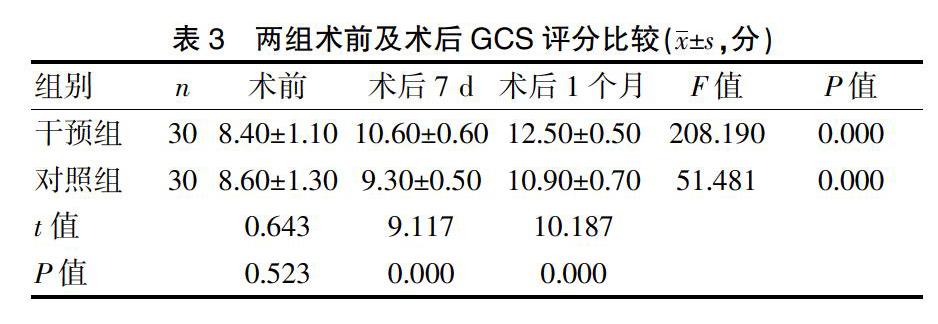智慧急救对颅脑创伤手术治疗患者预后的影响
2021-03-24冯方军徐龙彪温桂菲王成斌杜王维
冯方军 徐龙彪 温桂菲 王成斌 杜王维



[摘要] 目的 探討智慧急救对颅脑创伤手术治疗患者预后的影响。 方法 选择2018年6月至2020年1月在我院手术治疗的颅脑损伤患者60例为研究对象,随机分为干预组与对照组,每组各30例。对照组采用常规急救措施,干预组采用智慧急救措施。比较两组术中不良反应发生率,术后GCS评分、FMA评分及GOS评分。 结果 ①干预组术中心率>100次/min的发生率显著高于对照组,差异有统计学意义(P<0.05)。②术后7 d、1个月干预组GCS评分均显著高于术前,差异有统计学意义(P<0.05);术后1个月对照组GCS评分显著高于术前,差异有统计学意义(P<0.05);术后7 d、术后1个月,干预组GCS评分显著高于对照组,差异有统计学意义(P<0.05)。③术后3个月,两组FMA评分均显著高于术后1个月,差异有统计学意义(P<0.05);术后1个月与术后3个月,干预组FMA评分均显著高于对照组,差异有统计学意义(P<0.05)。④干预组GOS评分优于对照组,差异有统计学意义(P<0.05)。 结论 智慧急救可优化颅脑创伤手术急救流程,改善患者的预后。
[关键词] 智慧急救;颅脑创伤;手术治疗;预后
[中图分类号] R651.1 [文献标识码] A [文章编号] 1673-9701(2021)03-0005-04
The influence of intelligent emergency on the prognosis of patients undergoing craniocerebral trauma surgery
FENG Fangjun XU Longbiao WEN Guifei WANG Chengbin DU Wangwei
Operating Room, Zhuji People′s Hospital in Zhejiang Province, Zhuji 311800, China
[Abstract] Objective To explore the impact of the intelligent emergency on the prognosis of patients undergoing craniocerebral trauma surgery. Methods Sixty patients with craniocerebral injury who were surgically treated in our hospital from June 2018 to January 2020 were selected as the research objects and randomly divided into the intervention group and the control group, with 30 cases in each group. The control group used conventional first-aid measures, and the intervention group used intelligent emergency measures. The incidence of adverse reactions, postoperative GCS score, FMA score, and GOS score was compared between the two groups. Results ①The incidence of heart rate>100 times/min during the operation in the intervention group was significantly higher than that in the control group, and the difference was statistically significant (P<0.05). ②The GCS score of the intervention group 7 days and 1 month after the operation was significantly higher than that before the operation, and the difference was statistically significant(P<0.05). The GCS score of the control group 1 month after the operation was significantly higher than that before the operation, and the difference was statistically significant (P<0.05). Seven days after surgery, and one month after surgery,the GCS score of the intervention group was significantly higher than that of the control group, and the difference was statistically significant(P<0.05). ③The FMA scores of the two groups at three months after the operation were significantly higher than those at one month after the operation, and the difference was statistically significant(P<0.05). One month and three months after the operation, the FMA score of the intervention group was significantly higher than that of the control group, and the difference was statistically significant(P<0.05).④The intervention group′s GOS score was significantly different from that of the control group(P<0.05). Conclusion Intelligent emergency can optimize the emergency procedures of craniocerebral trauma surgery and improve the prognosis of patients.
既往研究显示,优化急救流程,可提高重症颅脑外伤急诊手术患者的救治效果[7]。唐文[7]的研究结果显示,通过优化急救流程,缩短院前急救时间、院内急救时间,可提高急救成功率,降低术后不良风险事件的发生率。都基刚等[8]研究显示,重度颅脑外伤患者的院前急救治疗,可以改善患者的神经功能损伤,提高患者的生活质量。智慧急救是近年来提出的一种急救概念,与近年来物联网的发展密切相关。智慧急救系统在急救车接诊患者后通过读取患者的身份信息,即可在车载电脑自动调取健康档案,供接诊医护人员调阅。在急救车上,可自动采集患者的医疗数据,包括生命体征、心电图等,保存这些数据,并能实时将这些数据传输给急诊科,使急诊科医护人员及时了解患者的具体情况,并能制订相应的处置措施,提前做好准备,为及时提供院内急救提供条件,缩短入院后向急救人员了解患者情况的过程,缩短急救时间[9-12]。急救人员在救护车上就可以通过平板填写电子急救病例,对患者的病情进行初步判断,并且对处置方法等都记录在案,这些信息也可实时传给急诊科接诊医护人员,让急诊医护人员对患者病情提前了解。院前急救告知系统可详细通告目前出诊急救车的状况,使院内医护人员实时了解急救车的出诊信息,做好接诊准备[13-15]。通过信息的实时传递,急诊科医护人员还可以与急救人员进行会诊。在实地信息的分享过程中,还可以及时协调医院急救抢救室资源、CT等辅助检查资源、特殊药物准备,急救抢救室资源,手术室资源、ICU床位等,在院前就为接诊后患者的处置提前做好准备,缩短协调时间,为争分夺秒抢救患者提供条件[16-18]。院前急救信息共享将急救信息完整地传递给医院的急诊中心,将交接内容提前向急诊接诊人员推送,减少了交接不清,病情交接信息之后等情况,缩短交接时间,提高交接效率[19-20]。
本研究中,干预组应用智慧急救系统,通过协调院前院内急救,缩短了患者急救时间,改善患者的预后,并且患者在术中的不良反应发生率也相对较低。智慧急救系统是基于物联网的一种新的急救概念,随着我国信息技术的发展,相信其在医疗系统会有更广阔的的应用空间。
综上所述,智慧急救可优化颅脑创伤手术急救流程,减少术中不良反应情况,改善患者的预后。
[参考文献]
[1] 朱晨,孟华,朱杰.基于云架构的区域智慧急救平台设计[J].中国卫生信息管理杂志,2020,17(1):57-61.
[2] 朱爱华,金吉明,吴艳杰,等.智慧急救下的现代急救云平台在胸痛绿色通道中的应用效果[J].广西医学,2020, 42(4):499-501.
[3] 凌晓阳.持续颅内压监测在中重型颅脑损伤治疗中的应用价值[D].南京:南京医科大学,2018.
[4] Reith FC,Van den Brande R,Synnot A,et al. The reliability of the Glasgow coma scale:A systematic review[J].Intensive Care Med,2016,42(1):3-15.
[5] Michaelsen SM,Rocha AS,Knabben RJ,et al.Translation,adaptation and inter-rater reliability of the administration manual for the Fugl-Meyer assessment[J].Rev Bras Fisioter,2011,15(1):80-88.
[6] McMillan T,Wilson L,Ponsford J,et al.The Glasgow outcome scale-40 years of application and refinement[J].Nat Rev Neurol,2016,12(8):477-485.
[7] 唐文.优化急救护理流程对重症颅脑外伤急诊手术患者的救治影响分析[J].中国现代医生,2020,58(2):173-175,179.
[8] 都基刚,任美英,王德仙.重型颅脑外伤患者院前急救治疗对神经功能损伤的影响[J].吉林医学,2020,41(1):165-166.
[9] 张露,王雅雯,陈萍萍,等.院前急救与5G网络医疗护理未来趋势及应用[J].世界最新医学信息文摘(连续型电子期刊),2020,20(60):296-297.
[10] 程兆辉,贺知菲,吴开明.智慧医疗背景下心脑血管疾病医疗救治信息平台[J].解放军医院管理杂志,2020, 27(4):350-353.
[11] 张小亮,王忠民,戴作雷,等.基于“绿色医嘱”模式的急诊多中心智慧急救系统建设思考[J].中国数字医学,2020, 15(2):42-44.
[12] 余荣贵,陈维.智慧医疗急救服务体系建设与研究[J].中国急救复苏与灾害医学杂志,2019,14(4):379-382.
[13] 周敬梅,曹敏,涂智辉,等.助力智慧城市的宜昌智慧急救模式的应用与研究[J].医学信息,2019,32(6):27-28.
[14] 谭伟良,杨齐英,周振祥,等.苏州智慧急救模式探索与实践[J].中华灾害救援医学,2019,7(6):347-349.
[15] 吉洪煦,汤景云,顾嘉奇,等.基于区域智慧急救的卒中中心系统设计与应用[J].中国卫生信息管理杂志,2019, 16(5):593-595.
[16] 李晨,韩翔,吴丹红.智慧医疗对优化急诊救治流程的意义[J].复旦学报(医学版),2019,46(1):95-97.
[17] 仲毅俊.RFID技术在院外急救设备管理上的应用研究[J].中国急救复苏与灾害医学杂志,2018,13(8):790-793.
[18] 王鑫,刘红梅.“互联网+”与智慧急救的发展探讨[J].中华灾害救援医学,2016,4(3):159-162.
[19] 谢明,梁红璇,张亮.建立“互联网+”智慧院前急救模式的探讨[J].灾害医学与救援(电子版),2018,7(1):1-3.
[20] 刘军,谢云,汪方,等. 5G应用于严重多发伤救治的探索[J].中华急诊医學杂志,2019,28(10):1242-1244.
(收稿日期:2020-10-23)
